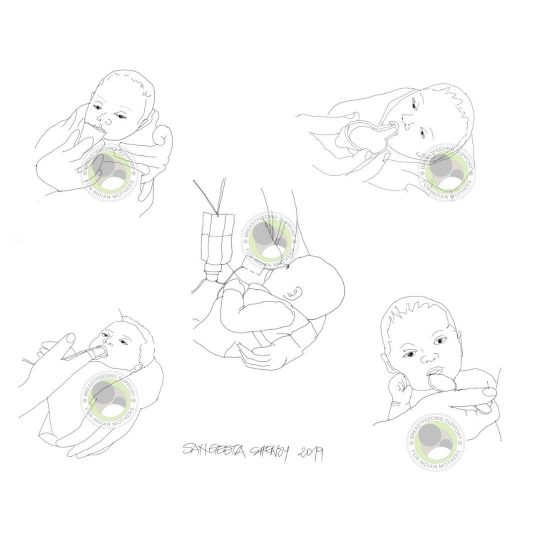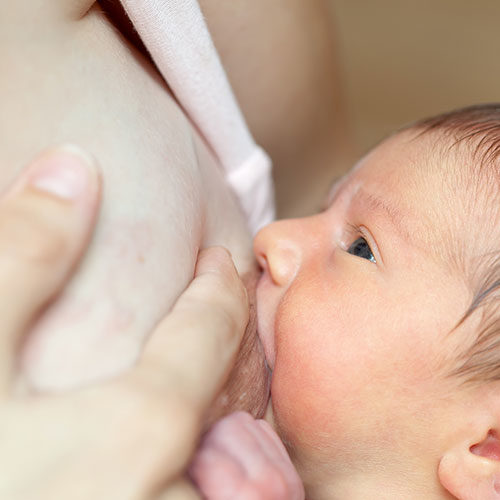Alternatives To Bottles
Many mothers use bottles to feed either Expressed Breast Milk (EBM) or
Breast Milk Substitutes (BMS) to their babies. When a baby is not directly breastfeeding, usually the most often considered option is always a bottle. It is important to know that there are other alternatives available to feed the baby.
Risks of Bottle-Feeding:
Bottle feeding comes with its own increased risks, such as:
- Developing diarrhoea
- Nipple confusion and bottle preference
- Overfeeding and associated childhood and adult obesity
- Suboptimal jaw development,
- Dental caries
- Speech impairment etc, to name a few.
Weaning off bottles because of preference for the bottle is a Herculean task in itself, which has proven to be quite challenging for many mothers.
Advantages of using Alternatives to Bottles :
All the risks associated with bottle feeding are eliminated when alternatives are used to feed a baby. Apart from that, the alternatives mentioned above like cups, shot glasses, spoons, paladai etc are much easier to clean and sterilise as compared to bottles. They are also more easily available in Indian households. Using these alternatives make the transition to breast easier, simpler and faster.
Alternatives:

Image created by Sangeeta A Shenoy
There are many alternatives available through which a baby can be offered EBM/BMS. Let’s consider them individually.
- Open cups –

Babies can drink from small open cups. It takes a bit of getting used to, but most feeding methods (including breastfeeding sometimes) take a bit of practice. The ideal size of the cup is small, with a capacity of 1-2 oz (30-60 ml). Babies don’t drink from a cup like adults by gulping the contents, they lick it like kittens. Individual experiences of doctors and mothers show that even preterm babies born at 32 weeks gestational age can drink from a cup.
Steps to feed a baby from an open cup –
- Have the baby in an upright position on your lap. A lot of mothers find it easier to keep the baby seated sideways in the lap.
- The Baby’s neck should be well-supported.
- Bring the cup to the baby’s mouth, place the rim of the cup on the baby’s lower lip and tilt it a bit to let the milk (EBM/BMS) just touch the baby’s lips.
- Wait for the baby to start lapping it up. Baby herself will decide the speed and rhythm that’s comfortable for her.
- Never pour the milk into the baby’s mouth as it can be a choking hazard. Just ensure that the cup is tilted enough for the milk to just touch the baby’s lips.
- When the baby pauses while drinking, patiently wait, without removing the cup from her lips.
2. Paladai –

Paladai is a traditional Indian cup with a spout. However, it’s different in the sense that it is low and the spout protrudes from the side in a triangular shape like an Aladdin’s lamp. The design of a paladai makes it easier to be used as a feeding cup. It reduces the spillage of milk to a great extent and helps the baby drink a larger amount in less time.
Steps to feed a baby from a paladai –
- Keep the baby in an upright position. Sideways in the lap is most comfortable. The baby’s neck should be well-supported.
- Bring the paladai to the baby’s mouth and tilt the paladai enough for the milk to touch the baby’s lips.
- The baby will slowly start pouting in order to accommodate the shape of paladai and will start drinking from it.
- Do not insert the spout into the baby’s mouth and let the baby decide the speed of drinking.
3. Spoon –

A small sized spoon with an elongated shape works well to help a baby drink milk from it. A cup of milk should be ready by the side in order to refill the spoon as soon as possible each time it’s finished by the baby, to not break the feeding flow.
Steps to feed a baby with a spoon –
- Keep the baby in an upright position, sideways in the lap; supporting the baby’s neck with one palm.
- Fill a spoon full of milk and bring it to the baby’s mouth and place the tip of the spoon on the baby’s lower lip.
- Baby will start licking it up and drinking at her own speed. Keep the spoon at the lower lip of the baby and keep tilting it to keep the milk in the spoon touching the baby’s lip.
- Do not pour milk into the baby’s mouth.
- Fill the spoon immediately each time to try and not break the flow of feeding for the baby.
4. Shot glasses –

These are just like open cups, only shaped differently. These are easier to hold for the feeder. The rest of the method is the same as feeding on a cup.
5. Syringe –
Syringes can be used when the above methods are difficult or when the baby needs to be fed the top milk only temporarily (for a few feeds) or occasionally. Important note: The needle should not be attached to the syringe.
Steps to feed a baby with a syringe –
- Fill the syringe with milk.
- Bring it to the baby’s mouth and insert just the tip in the baby’s mouth.
- As the baby pouts to accommodate the tip of the syringe in her mouth, press the plunger to release the milk into the baby’s mouth. It should be done slowly.
- Keep looking at the baby and respond to her cues. Pause when the baby pauses to swallow. Then release some milk again.
6. Dropper –
Droppers can also be used similarly to syringes when the need to use them is limited. Droppers are very small, having the capacity of 1-2 ml. Therefore, they are good to give colostrum to newborns who are not directly breastfeeding or require a top-up.
Steps to feed a baby with a dropper –
- Fill the dropper with milk.
- Insert the dropper into the baby’s mouth a bit.
- When the baby is ready to drink, press the dropper to release the milk from it.
- Since the dropper only holds about 1 ml of milk, sometimes, it can be inserted into the baby’s mouth and the milk can be released from it as the dropper touches the inner cheek wall.
7. Lactation Aid –

Lactation Aid is a system that helps a baby drink Expressed Breast Milk/ Breast Milk Substitutes in one of the most ideal ways – with her suckling needs to be met at the breast. In this method, a tube is attached or inserted into a container or a syringe. The other end of the tube goes in the baby’s mouth, from where she drinks. However, instead of offering only the tube (like a straw), it is offered to the baby with something else.
- Lactation aid at the breast – here, the tube is taped onto the mother’s breast, and it is inserted into the baby’s mouth at the nipple when the baby latches onto the breast. So, when the baby suckles, she is actually drinking the milk coming to her from the tube. This method works wonders in cases where the mother is working on her supply as her breasts are getting stimulated as well.
- Lactation aid with finger feeding – here, the tube is taped onto the caregiver’s clean finger. The finger is inserted into the baby’s mouth along with the tube. When the baby sucks, she gets the milk from the tube. This method is helpful for non-lactating single parents, transgender parents and/or other caregivers.
If you are seeking one-on-one lactation support from the comfort of your home, Breastfeeding Support for Indian Mothers offers Online Lactation Consultation, which can be booked here.
We also provide volunteer support on our 24X7 support group on Facebook, which you can join by clicking here.
P.S.: We do not accept Facebook profiles with inaccessible information. If your profile is locked/ inaccessible, you will need to send a Personal Message to our Facebook Page to join our free Facebook support group.
References :
https://kellymom.com/ages/newborn/newborn-concerns/alternative-feeding/
https://www.askdrsears.com/topics/feeding-eating/breastfeeding/faqs/alternatives-bottles
https://www.llli.org/breastfeeding-info/bottles/
Wish to speak with a member of our team who is a certified lactation professional and also an experienced breastfeeding mother, click on this link.
Medical Advice Disclaimer
THIS WEBSITE DOES NOT PROVIDE MEDICAL ADVICE.
The information, including but not limited to, text, graphics, images and other material contained on this website are for informational purposes only. No material on this site is intended to be a substitute for professional medical advice, diagnosis or treatment. Always seek the advice of your physician or other qualified health care provider with any questions you may have regarding a medical condition or treatment before undertaking a new health care regimen, and never disregard professional medical advice or delay in seeking it because of something you have read on this website.
Disclaimer
We understand and acknowledge that parents and babies can be of various genders on a spectrum of LGBTQI+. Families come in diverse flavours. However, in our articles, for the sake of simplicity and convenience, we will be referring to the breastfeeding parent as the mother and using the female pronouns- ‘she’ and ‘her’ for babies. Babies can be nourished and nurtured in different ways and while we have used the terms breastfeeding and nursing, we recognize that parents can opt to chest feed or finger feed.
We don’t have conflicts of interest and declare, and we are compliant with the WHO code of marketing of breastmilk substitutes and the IMS act.
In case you find any information on this website that needs to be updated, please write to us at info@bsim.org.in






